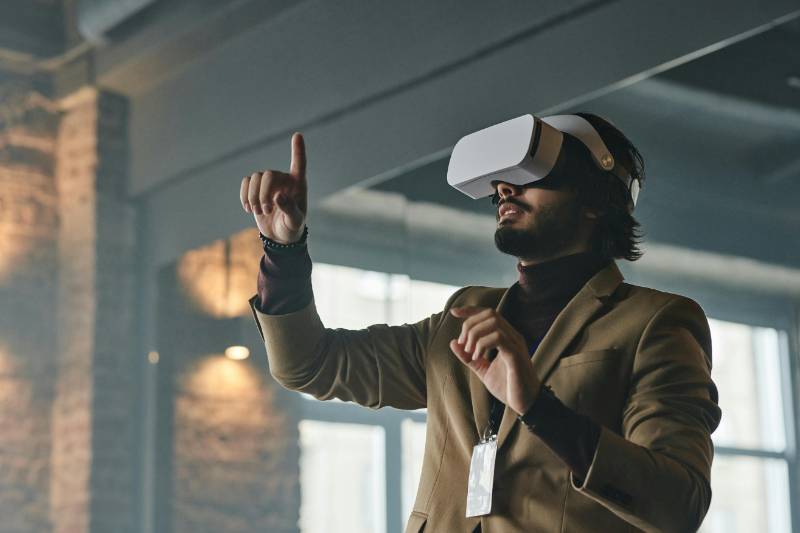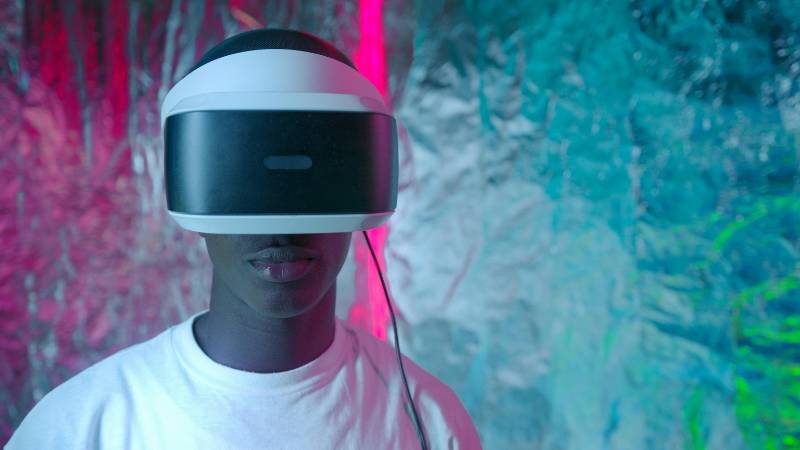
Augmented Reality in Retail: How Virtual Try-Ons Are Boosting Sales
10 min read
12 Oct 2025
Introduction
Augmented Reality (AR) has moved beyond gaming and entertainment to become one of the most influential technologies shaping modern retail. By merging the physical and digital shopping worlds, AR allows consumers to interact with products virtually, visualize them in real-life scenarios, and make more confident purchase decisions. One of the most innovative applications of AR in retail is the concept of virtual try-ons, which are revolutionizing how customers shop for clothes, beauty products, eyewear, and even furniture. These immersive experiences not only make shopping more fun and interactive but also boost consumer trust in online and offline purchasing.
The Rise of AR in Retail
The retail industry has seen a massive digital transformation in the past decade, accelerated by the growth of e-commerce and changing consumer behavior. AR has become an essential tool for brands trying to bridge the gap between the online and physical shopping experience. By allowing consumers to "try before they buy" in a virtual setting, retailers are solving one of the biggest barriers to online shopping—uncertainty. Companies like Nike, Sephora, IKEA, and Warby Parker have already embraced AR technologies to enhance customer engagement, and smaller retailers are following suit as AR development becomes more affordable.
Why Virtual Try-Ons Matter
For consumers, virtual try-ons provide an interactive, personalized, and stress-free way to evaluate products. Instead of relying on static images or product descriptions, shoppers can visualize items directly on themselves or in their environment. This creates a sense of ownership and significantly reduces buyer hesitation. For retailers, the technology brings measurable business benefits: increased sales, reduced return rates, and improved customer loyalty. Studies show that customers who use AR try-ons are more likely to complete purchases and less likely to return products due to dissatisfaction.
Benefits of Virtual Try-Ons for Retailers and Consumers
- Increases consumer confidence by showing realistic product visualizations
- Reduces return rates by minimizing size, color, and fit mismatches
- Boosts sales conversions as hesitant buyers feel more assured
- Enhances customer engagement with interactive shopping experiences
- Provides brands with valuable consumer behavior data through AR analytics
AR in Fashion and Beauty
Fashion and beauty brands have been among the earliest adopters of AR. Companies like Gucci, Zara, and H&M are experimenting with AR-powered fitting rooms and mobile apps that let customers virtually try on clothes. Similarly, beauty brands such as L’Oréal and Sephora use AR apps to allow customers to test makeup products—lipsticks, eyeshadows, and foundations—without needing physical samples. This not only improves hygiene but also provides a convenient way to explore multiple shades and styles instantly. The personalization offered by AR in fashion and beauty is a major driver of customer satisfaction and loyalty.
AR in Eyewear and Accessories
Eyewear companies like Warby Parker and Ray-Ban have introduced AR try-on features that enable customers to see how frames look on their faces in real-time. Accessories such as watches, jewelry, and hats can also be tried virtually. This reduces the challenge of shopping online for items where physical appearance and fit are critical to the purchase decision.
AR in Furniture and Home Decor
Furniture retailers such as IKEA, Wayfair, and Home Depot are leveraging AR to allow customers to place 3D models of sofas, tables, and decor items directly into their living spaces using smartphones. This helps buyers visualize the size, design, and color match before making a purchase. For large or expensive items, this feature significantly reduces post-purchase regrets and the cost of returns.
Impact on Customer Experience
Virtual try-ons enhance the customer journey by making it more interactive, personalized, and fun. Instead of browsing static catalogs, shoppers feel like participants in a tailored shopping experience. The novelty of AR also creates a "wow factor" that helps brands stand out in a competitive market. As consumers become more tech-savvy, they increasingly expect retailers to provide AR-enhanced shopping tools as part of their customer experience strategy.
Challenges in Implementing AR
- High development and integration costs for AR platforms
- Compatibility challenges across smartphones, tablets, and AR wearables
- Technical limitations in accurately rendering products in real environments
- Customer learning curves when using new AR features
- Privacy and data collection concerns regarding facial scans and personal information
Overcoming Challenges
Retailers can overcome these challenges by partnering with AR tech providers, adopting scalable solutions, and focusing on user-friendly designs. As AR hardware and software continue to improve, costs are expected to decrease, making the technology more accessible for mid-sized and small retailers.
The Future of AR in Retail
The future of AR in retail is incredibly promising. With the rise of AI-powered personalization, AR try-ons will become even more accurate and tailored to individual shoppers. Imagine virtual fitting rooms that recommend outfits based on body measurements, past purchases, and current fashion trends, or beauty apps that analyze skin tone and suggest products accordingly. As 5G connectivity expands, AR apps will run smoother, making real-time try-ons more seamless. Furthermore, AR will likely play a significant role in the metaverse, where consumers will shop in virtual stores, interact with 3D avatars, and experience products in entirely new ways.

Case Studies of AR Success
- Sephora’s Virtual Artist app increased customer engagement significantly by letting users try over 2000 shades of makeup virtually.
- IKEA Place app became one of the most downloaded AR shopping apps, helping millions of customers visualize furniture at home.
- Warby Parker’s AR try-on for glasses reduced customer hesitation and became a standard part of its online shopping experience.
Conclusion
Augmented Reality is no longer a futuristic concept—it’s a present-day necessity for retailers who want to stay competitive. Virtual try-ons are not just about fun gimmicks; they directly impact sales, returns, and customer satisfaction. As AR technology evolves, it will continue to redefine how consumers shop, making experiences more immersive, personalized, and convenient than ever before. Retailers who adopt AR early and strategically will have a clear advantage in capturing the next generation of digital shoppers.
FAQs
How do virtual try-ons increase retail sales?
Virtual try-ons help customers feel more confident about their purchases by allowing them to see how products look in real time. This reduces hesitation, minimizes abandoned carts, and boosts sales conversions by up to 30%. With better visualization, customers make quicker, informed decisions, improving both shopping experiences and retailer profitability.
Which industries are most impacted by AR try-ons?
Fashion, beauty, eyewear, and furniture industries are the most impacted by AR try-ons. Fashion benefits from virtual fitting rooms, beauty brands allow testing thousands of shades, eyewear companies showcase frames, and furniture retailers help customers visualize products in their homes, reducing uncertainty, returns, and enhancing customer satisfaction significantly.
Are AR try-ons completely accurate?
AR try-ons are highly accurate, offering realistic views of products, though not flawless. Factors like lighting, camera quality, and device compatibility can affect accuracy. With continuous advancements in AI and machine learning, AR solutions are becoming increasingly precise in representing colors, textures, and sizes, delivering a reliable shopping experience.
What challenges do retailers face when adopting AR?
Retailers face challenges like high development costs, integration with existing platforms, and device compatibility. Privacy concerns around personal data, such as facial scans, also arise. Additionally, customer adoption may be slow. Overcoming these issues requires investment in secure, scalable, and user-friendly AR technologies for sustainable and successful integration.
What role will AR play in the future of e-commerce?
AR will become central to e-commerce by making online shopping immersive, interactive, and personalized. Integration with AI and the metaverse will enhance product recommendations, create virtual malls, and boost engagement. With 5G improving speed and performance, AR adoption will accelerate, shaping the future of global online retail experiences.
Can AR help reduce product returns?
Yes, AR can greatly reduce product returns. By letting customers visualize products accurately in size, style, and color, AR prevents mismatches that often lead to returns. This lowers operational costs for retailers, minimizes waste, and boosts overall customer satisfaction, making the shopping experience smoother and more reliable for buyers.
Is AR adoption only feasible for big brands?
Initially, big brands like Sephora and IKEA led AR adoption. Today, AR has become accessible for small businesses through SaaS tools and plug-and-play solutions. Smaller retailers can now integrate AR features affordably into their apps or websites, making this technology feasible beyond just large companies with big budgets.
How does AR enhance customer engagement?
AR enhances customer engagement by making shopping interactive and fun. Instead of just browsing, customers actively try products virtually, creating a gamified experience. This increases time spent on shopping platforms, strengthens brand loyalty, and makes the process memorable. AR transforms shopping from a task into an immersive, enjoyable journey.

The AR Breakthrough That Will Make Blockchain Transactions Simpler Than Ever!
7 min read | 11 Oct 2025
How AI Is Making Blockchain Smarter and Safer – The Inside Scoop!
5 min read | 10 Oct 2025
The Big Tech Twist: How VR Is Set to Disrupt Blockchain Like Never Before!
5 min read | 09 Oct 2025
Unlocking the Power of AR: How Augmented Reality Is Set to Revolutionize Blockchain!
6 min read | 08 Oct 2025More Articles

Smart Infrastructure: Enhancing Urban Resilience with Technology
5 min read | 08 Jul 2025

Cryptocurrency Investment Strategies: Navigating Volatility
7 min read | 07 Jul 2025

Emerging Trends in Digital Payments and Fintech
5 min read | 06 Jul 2025

Robotics in Space Exploration: Building the Future on Mars
4 min read | 05 Jul 2025
More Articles

Cyber-Physical Systems: Bridging Physical and Digital Worlds
4 min read | 20 Sep 2025

Quantum Internet: The Next Generation of Secure Communication
7 min read | 19 Sep 2025

Swarm Robotics: Collective Autonomous Systems
6 min read | 18 Sep 2025

Bioinformatics: Merging Biology with Data Science
4 min read | 17 Sep 2025
